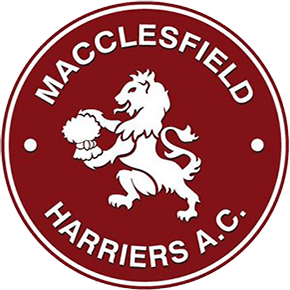Written by John Heaford, 1984, in the Club Magazine Issue 4
Parts 1, 2 and 3 dealt with the original history of our Club covering the period 1945/46 up to 1974/76. Arthur Evans has handed over his pen to John Heaford, who writes from London and has kindly agreed to cover the period of his own involvement.
Early history
Readers of Arthur Evans’ early history articles will note that I first emerged as an athlete when I was Captain of the Track team. The Club boated [unreadable] members and survived fir 18 months. The most notable performers included Bill Renard and Glenn Evans, both sub-2 minute half milers. Competition was rare, whilst training was even rarer! Nevertheless, there was interest which extended to a sponsored 20 mile run to raise funds for an official club strip. Green vests and red shorts … I still have mine!
A new start – 1974 to 1976
Older and wiser, and with 6 years of business experience under my belt, I took on the task of helping to revive the Macclesfield Harriers and Athletic Club. Along with Arthur Evans, Brian Furness, John Guterson, Dick Sudell, Bruce McLean, Mike Banister and many others we reformed the existing Club at Macclesfield Town Hall in 1974. I became Secretary. You have heard from Arthur, in the last edition, how this new Club launched its first Championships at the Rugby Club. It may have sounded primitive, and for all practical purposes it was.
But don’t be deceived! There was a propaganda and publicity machine which is unrivalled today. John Guterson designed the Club’s emblem to stand out on badges, letterheads and track suits (is it still used today?).
The Club’s all black strip was getting noticed at cross-country and track meetings. [We] write many articles and reports in the local [press].
By the end of 194/75 winter season we were beginning to roll.
Andrew Street was taking the Under 13 cross-country matches by storm, regularly in the first 3. The growth of members in the U13 group was alarming and I felt at that time that, if held together, here was the nucleus which would guarantee the Club’s future. I set to work on a five year plan to feed this age group with new talent whilst ensuring the progress of every subsequent age group through:
- Sound coaching – winter and summer in all events
- Sound team management
- Effective fund raising
- Adequate competition, and
- Outrageous publicity.
I decided that I would measure success in several ways. At the end of each season I would analyse four things:
- Active Club membership
- Active Committee membership
- Cross-Country/Road Race performance
- AA Standards achieved – Track and Field
I set out a plan that I hoped would result in one of the strongest clubs in the north of England. My aim was simple – to convince the Local Authorities to build the one thing we lacked: a running track. The plan I devised was written down and I kept it over the y year struggle, to remind myself of my original objectives.
Just how successful it proved to be must be judged in Parts 5 and 6, but for now let’s continue with the story.
We began the 1975 Track season, after a very successful cross-country season, with a series of inter-club matches. These mostly displayed Macclesfield’s growing wealth of talent in the Under 11 and Under 13 ages.
On a Wednesday evening in July, a young female sprinter, 12 year old Helen Bottomley, ran into the local record books with a 12.5 sec 100 metre run — still an unbeaten record [ED: This Record still stands for all females in the Club, as of Dec 2019].
The season ended with the first ever match win by the Club – hailed by Joe Lancaster in the Manchester Evening News as Macclesfield’s “El Dorado”. After two years pf trying Macclesfield H & AC won the inter-club match at Stockport with 134 points to Bolton’s 56, and Stockport’s 50. The other four teams were out of contention.
Throughout the winter of 1975/76 the cross-country teams grew in strength, with Andrew Street still hitting the headlines. Girls too, began to get star billing with names like Wendy Haworth prominent in weekly reports. Winter track meetings began to feature too, with athletes travelling to Stretford to test the progress of their winter training. This latter was organised like clockwork at the Macclesfield College of Education.
The 1976 track season began with the biggest team so far assembled, including U15 and U17 age groups. The unquestionable highlight of the season was a story which made headlines on the sports pages of the Macclesfield Express: “Two Macclesfield girls, Christine James and Helen Bottomley, qualified to the Women’s AAA Champs with sub-13 second 100 metre runs.”
A month later the Under 15 Girls won the Cheshire 4 × 100m Relay Championship – the first ever County title – which went on to prove a very successful event for the Club.
During this season, a young middle distance runner began his career with headlines in the summer. 10 year old Paul Beech set a Club 800 m record of 2 min 36.8 seconds. At the end of July, with a match every weekend strengthening their experience, the Club won several inter-club matches. By now, weekly ½ to ¾ page reports appeared in the Macclesfield Express. A total of 106 athletes competed in the Club Championships, when many Club records were broken. Two more massive wins in inter-club competitions – one match saw MHAC field 65 athletes – sealed a tremendous season.
